Established in 1954, Kanwar Wildlife Sanctuary is located in Bhuntrer Tehsil of Kullu District in Himachal Pradesh, India. Regarding biodiversity, the wildlife sanctuary located in Parvati Valley of Kullu district in the Himalayan range is significant. Manikaran, a popular pilgrimage and tourist place known for its hot springs, is situated near the wildlife sanctuary. The area of the sanctuary is 107.29 sq. km and it is located approximately 240 km. from Shimla and 42 km. from Kullu in Kullu District. It is home to a viable population of the “Himalayan Tahr”. This is a high-altitude sanctuary that encompasses narrow valleys, sharp inclines, and rocky cliffs.
The Kanwar Wildlife Sanctuary is one of the few areas in the western Himalayas with semi-natural flora and fauna across temperate, subalpine, and alpine zones, hosting high species diversity. It shelters many species listed in the IUCN Red List and CITES appendices, such as the Monal, Himalayan Black Bear, Himalayan Brown Bear, Common Leopard, etc.
The area has a great scenic beauty and offers tough treks through varied vegetation. The sanctuary is full of natural camping sites. The famous Sar Pass trek passes through Kasol Gad and Grahan Gad/Nala, eventually reaching Grahan village, which serves as the second camp (with Kasol as the base camp) and acts as a gateway to the Kanwar Wildlife Sanctuary. Grahan village is also home to the Rawal Rishi temple, adding cultural significance to the trekking route.
History of Kanwar Wildlife Sanctuary
- In 1886, scientific forest management in Kullu began with Mr. Fischer’s first working plan, focusing on Deodar for export.
- Mr. Trevor revised the working plan from 1915-1931, emphasizing a uniform system of forest management. He established four working circles: Regular Working Circle, Fir Working Circle, Selection Working Circle, and Unregulated Working Circle.
- Mr. Semler conducted the second working plan revision from 1931-1934, maintaining the same management objectives as the previous plan.
- From 1947-1949, Sh. K.L. Aggrawal revised the working plan, maintaining the same number of working circles.
- In 1954, the Kanwar Wildlife Sanctuary was notified under the Punjab Birds and Wild Animals Protection Act, 1933, vide Punjab Govt. Notification No. 70-GP-53/07 dated 26th February 1954 with an area of 54.27 sq. km.
- During 1963-64, Sh. D.P. Kapoor conducted the fourth revision, establishing Regular, Fir, Protection, and Broad-Leaved Working Circles, and abolishing the previous Selection Working Circle.
- From 1979-80 to 1993-94, Sh. J.C. Sharma further revised the working plan for 15 years.
- Initially, the sanctuary remained under the Wildlife Division Shimla and Wildlife Division Palampur until 1984, when the Wildlife Division, Kullu, was established.
In 1986, complete control of this Protected Area was handed over to D.F.O., Wildlife Division, Kullu, as per Himachal Pradesh Govt. notification No. SC-A (1) 1/83 Vol-II dated 26.08.1986. - Since June 1984, Kullu Wildlife Division has managed Kanwar Wildlife Sanctuary. It encompasses all types of forestlands found in Kullu district, including RFs, 2nd class DPFs, and other Cultivated Land.
- In March 2004, the right holders’ enjoyment of their rights, recorded in the forest settlement report by Anderson in 1896, was suspended in pursuance of guidelines issued by MoEF&CC (letter No. 1-26/CEC/2003 dated 02.07.2004) following the Hon’ble Supreme Court order in IA No. 548 dated 14.02.2000.
- On 1st February 2014, the Governor of Himachal Pradesh declared 107.29 km² of Kanwar as “Kanwar Wildlife Sanctuary” (Notification No. FFE-B-F(6)-13/1999/Kanwar, dated 1st Feb. 2014) under the Wildlife (Protection) Act, 1972, following the Hon’ble Supreme Court order (IA No. 155, dated 01/02/2013) for the rationalization of boundaries.
- On 8th November 2021, the Government of India extended the Kanwar Wildlife Sanctuary boundary by 0 to 2.7 km as an Eco-sensitive Zone (64.655 sq. km), as per notification S.O. 4615(E) dated 8th November 2021. The zero extent is due to its connectivity with the Great Himalayan National Park on the southeastern side.
- Previously, a five-year management plan was planned from 1999-2000 to 2003-2004. Then, Sh. B.S. Rana, IFS, DFO WL Kullu, developed a ten-year management plan covering 2004-05 to 2013-14.
- The present ten-year management plan covering 2020-21 to 2029-30 is being planned by Rakesh Kumar (IFS), DFO of Wildlife Division Kullu, and Yogender Sharma (HPFS), ACF of Wildlife Division Kullu.
Kanwar Wildlife Sanctuary Boundary and Map
The boundaries of the Kanwar Wildlife Sanctuary are surrounded by the Parvati Forest Division on three sides, except for the southeastern side, which is adjacent to The Great Himalayan National Park, serving as a corridor for wildlife. The geographical coordinates of the sanctuary are as follows:
- Northern boundary: Latitude 32°00’21” N, Longitude 77°18’11” E
- Eastern boundary: Latitude 31°54’40” N, Longitude 77°27’03” E
- Southern boundary: Latitude 31°53’25” N, Longitude 77°24’41” E
- Western boundary: Latitude 31°57’25” N, Longitude 77°15’04” E
The altitudinal range of the Sanctuary spans from 1800 meters to 5056 meters above mean sea level (MSL), encompassing areas ranging from sub-tropical forest to alpine forest. The Kanwar Wildlife Sanctuary, situated in the inner Himalayas and marked on the hill station map of Kullu Manali along Parvati Valley, is defined by the following boundaries:
1. North:
The boundary starts at Jail Nal and follows R/4 Kasol C-VI-b and C-I up to 1800 meters contour line. Then it follows the 1800-meter contour line to Grahan Gad, then upstream along the Gad, following R/4 Kasol and Reona PF’s C-Il-b, C-ll-a, C-ll-d until it separates the cultivation land of Grahan village. Next, it traces Tilalotan PF’s boundary via SOI benchmark at 4056 meters, then downstream along a tributary to Dudhikhol Nal up to near SOI benchmark at 2838 meters.
2. East:
The boundary of the sanctuary begins at the confluence of a tributary in Dhudhikhol Nal and proceeds upstream alongside another tributary flowing into Dudhi Khol. Then, it moves downstream along a tributary flowing Barthi Nal before heading upstream of Barthi Nal. Following this, the boundary traverses a path leading to Ujli Runi Thach and continues along the ridge until it reaches the SOI benchmark at 4817 meters. Finally, it extends up to Phanchi Galu at 4636 meters, following the designated path.
3. South:
Starting from Phanchi Galu at 4636 mtrs., the boundary follows the ridge Ori Dhar, Rohni Dhar to SOI benchmark 4658 mtrs. Then, it descends to a tributary joining Hamkha Nal near Beghlo Thach and ascends with a small tributary to SOI 4330 mtrs. It then traces the southern boundaries of Reona PF and Kasol RF, passing various SOI benchmarks. After joining Ursu Nal, it ascends along the eastern boundary of Searan PF to SOI benchmark 3533 mtrs., then descends to Najan Gad and ascends again to SOI benchmark 3674 mtrs.
4. West
The boundary begins at SOI benchmark 3674 mtrs. and follows downstream with a Nala flowing to Jaram Nal until SOI benchmark 1895 mtrs. It then moves along the forest boundary of Muri PF, reaching SOI benchmark 3286 mtrs., before descending along Jail Nal up to the starting point of the northern boundary at R/4 Kasol C-VI-b.
Geography and Climate of Kanwar Wildlife Sanctuary
1. Geography:
The geography of Kanwar Wildlife Sanctuary is characterized by rugged terrain with steep slopes, rocky cliffs, and deep valleys. Altitudes range from 1800 meters near Kasol to 5056 meters at Sar Pass. The geology includes quartzite rock with clay layers on moderate slopes and mica schist and quartzite with sandy loam on others.
The area is characterized by high ridges, deep gorges, cliffs, and glaciers, with numerous nalas draining the landscape. Topographic factors like slope, aspect, and exposure affect temperature, wind movement, and erosion, resulting in diverse vegetation.

2. Climate:
The climate of Kanwar Wildlife Sanctuary can be divided into four distinct seasons:
- Summer: This season lasts from mid-April to June and sometimes extends into mid-July.
- Monsoon: The monsoon season runs from mid-July to mid-September.
- Autumn: Autumn occurs from mid-November to mid-December.
- Winter: Winter spans from mid-December to mid-March, though it can last longer if there are heavy rains, or be shorter if summer arrives early and the season is dry.
Throughout the year, temperatures in the sanctuary range from -10°C to 28°C. Kanawar Wildlife Sanctuary receives 80% of its precipitation from southwestern monsoons (July-September) and 20% from winter western disturbances. Heavy snowfall occurs from December to March, which is the main water source. October to December is dry. Annual rainfall at Kasol is 1000 mm and 321 mm of snowfall.
3. Water Sources:
The sanctuary is rich in water resources, with snow cover and abundant vegetation supporting numerous springs and drinking water sources. There are four perennial streams and many seasonal channels:
- Kasol or Grahan Gad/Nala (includes Mathigarh Nala, Garhunju Nala, Thunja Nala, Ratta Chamela Nala, Harloon Nala, Dolag Nala, Socha Nala)
- Jail Nala (includes Kundi Nala, Chamaun Nala).
- Shatt Nala (includes Shada Ra Nala, Mohasru Nala, Ujali Khar Nala, Kaliban Nala)
- Garsa Gad (includes Nanjan Gad/Nala, Ursu Nala, Marinu Nala, Pancha Nala, Pulia Nala, Dora Nala).
The streams are uniformly distributed and the area falls into two main watersheds: Grahan Gad/Nala, Jail Nala, and Shatt Nala drain into the Parvati River, while Garsa Gad drains directly into the Beas River.

Forest, Animals, and Birds of Kanwar Wildlife Sanctuary
Kullu Valley, also known as the “Dev Bhumi,” is home to various flora and fauna found in several sanctuaries and a national park. The sanctuary is rich in flora and fauna, with a wide range of plant species. It has various mountain terrain, varied climates, and vegetation, providing a congenial habitat for temperate wildlife.
1. Forest:
The Kanwar Wildlife Sanctuary has various forest types found within its boundaries. These include sub-tropical chir pine forests, moist Deodar forests, western mixed coniferous forests, moist temperate deciduous forests, Kharsu oak forests, Western Himalayan sub-alpine fir forests, and alpine pastures.
Moreover, the sanctuary harbours forests of Deodar, Fir, Spruce, and Kail among conifers, along with a wide range of broad-leaved species forming the understorey. These habitats support a variety of medicinal herbs and unique flora, enhancing the sanctuary’s ecological significance.
2. Animals:
The Kanwar Wildlife Sanctuary’s varied altitude and forest support a various type of Himalayan wildlife. Previous surveys confirm populations of Blue sheep, Bharal, Musk deer, Serow, Goral, Tahr, and various snakes and lizards.
IUCN Red-listed species include the Snow leopard, Himalayan black bear, Himalayan brown bear, Himalayan red fox, jackals, serow, civets, Himalayan tahr, Musk deer, Blue sheep, Goral, Monal, Koklas, Kalij, and Western Tragopan.
Among them, the Snow leopard is the most vulnerable. It is known for its elusive nature, inhabiting remote habitats, and preying on wild sheep, goats, and occasionally domestic livestock, leading to conflicts with humans.
Once abundant in Himachal Pradesh, both brown and Himalayan black bears now face serious threats. The former, less numerous than its cousin, prefers lower elevations near the tree line. Omnivorous by nature, both bear species exhibit intelligence and typically avoid humans. However, in surprise encounters, they may attack, often resulting in fatal injuries.
Animals found in Kanwar Wildlife Sanctuary during a partial census conducted in the years 2010 to 2013 have been tabulated in the following table.
| Table of partial census carried out in the Kanwar Wildlife Sanctuary |
|||
| Animal | 2010 | 2011 | 2012 |
| Black Bear |
2 | 1 | 3 |
| Himalayan Tahr | 8 | 12 | 10 |
| Civet cat | 5 | 0 | 8 |
| Goral | 10 | 11 | 8 |
| Leopard | 3 | 0 | 2 |
| Leopard cat | 2 | 4 | 3 |
| Languor | 3 | 0 | 2 |
| Monkey | 20 | 30 | 50 |
| Western Tragopan | 2 | 1 | 1 |
| Koklas | 20 | 23 | 25 |
| Brown Bear | 1 | 0 | 1 |
| Monal pheasant | 8 | 7 | 9 |
| Chukor | 4 | 5 | 0 |
| Kalij pheasant | 3 | 5 | 7 |
| Vulture | 12 | 15 | 0 |
| Cheer pheasant | 0 | 0 | 0 |
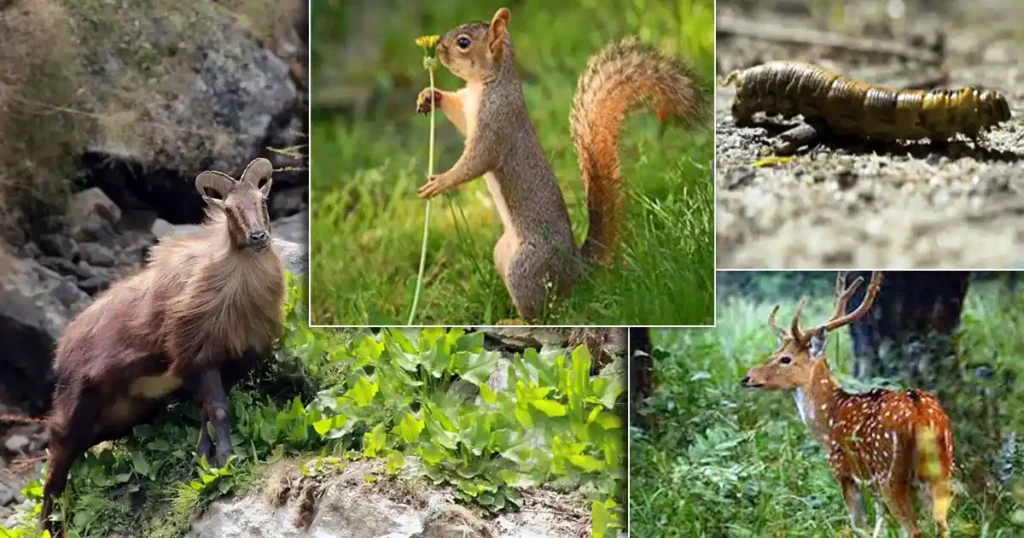
4. Birds:
Kanwar Wildlife Sanctuary is a haven for bird watchers. The best time to spot birds is in the early mornings and late afternoons. The sanctuary is famous for its variety of wild birds. Common birds found in the valley include the Black Kite, Ring-necked Parakeet, Verditer Flycatcher, Common Hoopoe, Yellow-billed Blue Magpie, Long-tailed Minivet, and various Thrushes, Tits, and Warblers.
Birds of prey commonly seen in the valley include the Booted Eagle, Lammergeier, Common Buzzard, Cinereous Vulture, and Golden Eagle. However, sightings of the Golden Eagle and Cinereous Vulture have become less frequent nowadays.
Monal, Koklas, Cheer, and Kalij pheasants inhabit the denser parts of the forest. A lucky few might glimpse the Western Tragopan, the state bird and a highly threatened species that can be heard calling at daybreak. It is found in parts of the sanctuary and the Great Himalayan National Park to the south.
The Monal, once the state bird of Himachal Pradesh, is also found in this protected area. Male Monals do a special dance before mating to impress females, which is beautiful to watch. In the past, people hunted pheasants for meat and their colorful feathers. They used to wear these feathers on their hats during traditional events, although this practice is declining now.
A bird count took place on May 4th and October 19th, 2019, coinciding with the celebration of Wild Bird Day on October 14th, in the Kanwar Wildlife Sanctuary. Below is a table summarizing the bird count data.
| Table: Bird count on May 4th and October 19th, 2019 | ||
| Sl. | Name of Bird Species | No. of Bird |
| 1 | Black yellow gross black | 4 |
| 2 | Blue-capped rock thrush | 1 |
| 3 | Blue Whistling thrush | 5 |
| 4 | Brown dipper | 3 |
| 5 | Common hoopoe | 2 |
| 6 | Common myna | 5 |
| 7 | Great Barbet | 1 |
| 8 | Grey Bush chat Female | 1 |
| 9 | Grey-headed woodpecker | 1 |
| 10 | Long tail myna | 2 |
| 11 | Pink-browed rose finch | 1 |
| 12 | Plumbeous water redstart | 4 |
| 13 | White Capped water redstart | 3 |
| 14 | Yellow-billed blue Magpie | 2 |
| 15 | Himalayan Bulbul | 4 |
| 16 | House Sparrow | 6 |
| 17 | Little forktail | 1 |
| 18 | Oriental white eye | 1 |
| 19 | Rufous bellied Niltava | 2 |
| 20 | White-browed Wagtail | 1 |
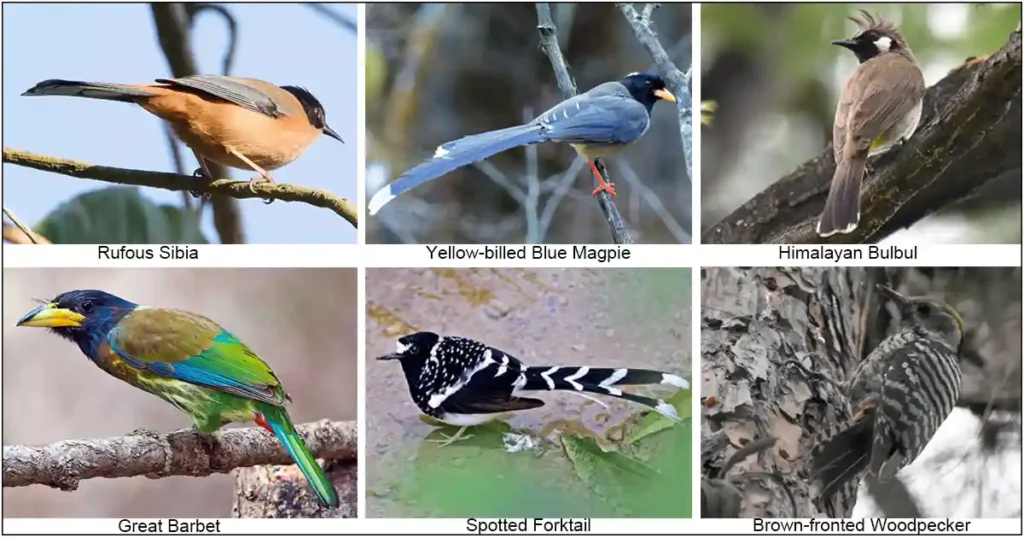
Things to do at Kanwar Wildlife Sanctuary
More than 4500 tourists visit the Kanwar Wildlife Sanctuary every summer. Rough walking trails and paths, along with a watchtower for wildlife observation and area scanning, constructed in 1999-2000, are available for visitors. The trekking programs arranged by YHAI (Youth Hostel Association of India) offer tough treks through varied vegetation and have great scenic beauty. The sanctuary is full of natural camping sites.
During trekking routes, the Sanctuary and the surrounding areas offer many things sighting such as the forested landscapes, snow-clad mountain peaks, and towering trees inhabited by birds and animals. This is undoubtedly one of the most approachable sanctuaries for sighting animals for wildlife enthusiasts.
1. Sar Pass Trek
Sar Pass Trek is the most visited easy-to-moderate trek of Kanwar Wildlife Sanctuary that spans 48 km. The best times to do the Sar Pass Trek are during the summertime, from mid-April to June, or during autumn, from September to mid-November.
a. Day 01: Kasol – Grahan Village
• Distance: 10 Km;
• Trek Grade: Gradual – Moderate
• Altitude: Kasol (5577ft.), Garhan Village (7700 ft.)
• Time Taken: approx. 4-5 Hrs.
• Overnight will be at Homestay or Trekking Tents
The Sar Pass trek begins in Kasol following the Parvati River through Grahan Village along the Grahan Nalah trail. This is an easy 10 km trek through dense coniferous forests and the aroma of pine trees. You’ll reach a clearing with grasslands and local vendors selling tea, snacks, and rhododendron syrup. From here, it’s a steep climb to Grahan Village. After about an hour of climbing, you’ll reach Grahan, situated on top of a hill, and camp there for the night. You can stay in guest houses or use the camping ground after crossing the village. There is a satellite phone in the village, and you might also get cell phone coverage.
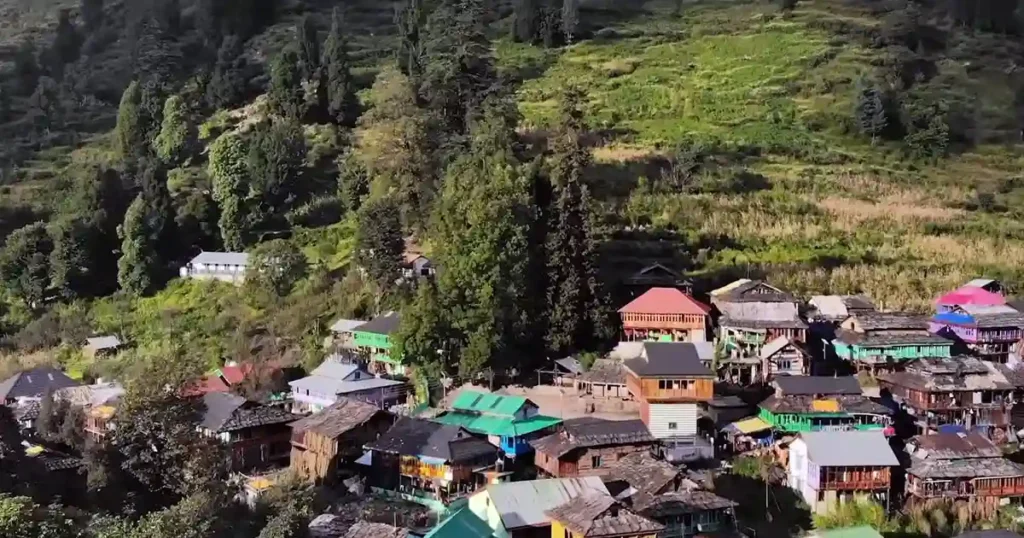
b. Day 02: Grahan – Min Thach
• Distance: 7 Kms;
• Trek Grade: Gradual- Moderate
• Altitude: Garhan Village (7700 ft.); Min Thach (11,155 ft.)
• Time Taken: approx. 4-5 Hrs
• Overnight stay at Trekking Tents
From the Grahan campsite, a gently climbing trail goes north to Min Thach, often used by villagers in the morning. After a while, the view opens, and a guide can point out Min Thach, Nagaru, and Sar Top on the right. The trail then becomes steeper and enters the woods.
After some time, you enter a dense forest where the thick canopy blocks most sunlight. The slope becomes steeper and the path confusing. After a few hours, the forest opens to a grassy ridge called Min Thach (“Thach” means meadow in the local language, where villagers bring their cattle to graze).
To the northwest, you can see the Chanderkhani range. The ridge continues east to a snow-covered cliff with the Nagaru campsite.
To the southeast are forests with cleared space for tents. A seasonal hut sells tea, coffee, and omelets. A nearby tap provides drinking water. You can camp here for the night, protected from strong winds. Dig trenches around tents for drainage in case of rain, hail, or snow.
Take one day to trek from Grahan to Min Thach for acclimatization. Seasoned trekkers can start early from Kasol, have an early lunch at Grahan, and reach Min Thach by afternoon.
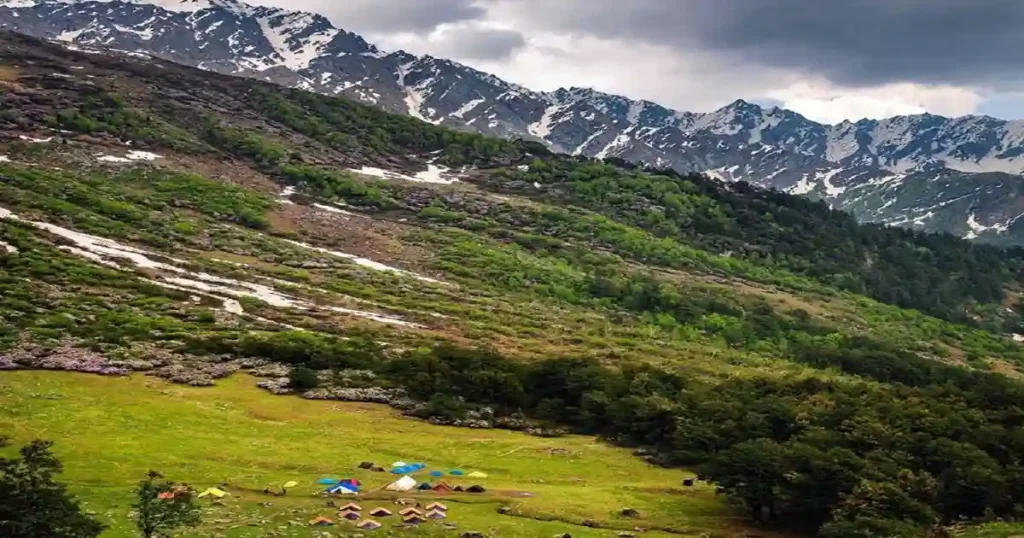
c. Day 3: Min Thach – Nagaru
• Distance: 6 Km
• Trek Grade: Gradual- Moderate
• Altitude: Min Thach (11,155 ft); Nagaru (12467 Ft)
• Time Taken: Approx. 4 Hrs
• Overnight stay at Trekking Tents
From Min Thach, Nagaru seems close, but the route veers south into the woods instead of going straight up the ridge. There may be snow, so start early as the weather is better before noon and the snow less slippery.
After a while, you reach a rocky ridge overlooking a grassy meadow. The ridge climbs steeply eastward to the cliffs where Nagaru sits. The well-marked path to Nagaru goes up this ridge for a few hundred meters before the tree line ends, giving way to grass and shrubs.
If there is snow, exercise great caution as this is the trickiest part of the trek. The slope is steep and slippery, and the trail may be hidden. A guide, trekking pole, waterproof gloves, and possibly an ice axe are essential. Use proper technique: dig your toes into the snow to establish a firm foothold before moving forward.
After a few hours, you reach the flat Nagaru campsite. From here, you can see the Parvati Valley, Manikaran, Chanderkhani range, and below, Min Thach and Grahan. To the south is a snowy expanse towards to Sar Pass, though the pass itself is not yet visible.
Network coverage is sporadic. Carry water from Min Thach as the tap near the western cliff edge may not work. Set up camp quickly due to strong winds and rapidly falling temperatures after sunset. Nights are bitterly cold, and tents can be blown away. Rest early for warmth and an early start the next day.
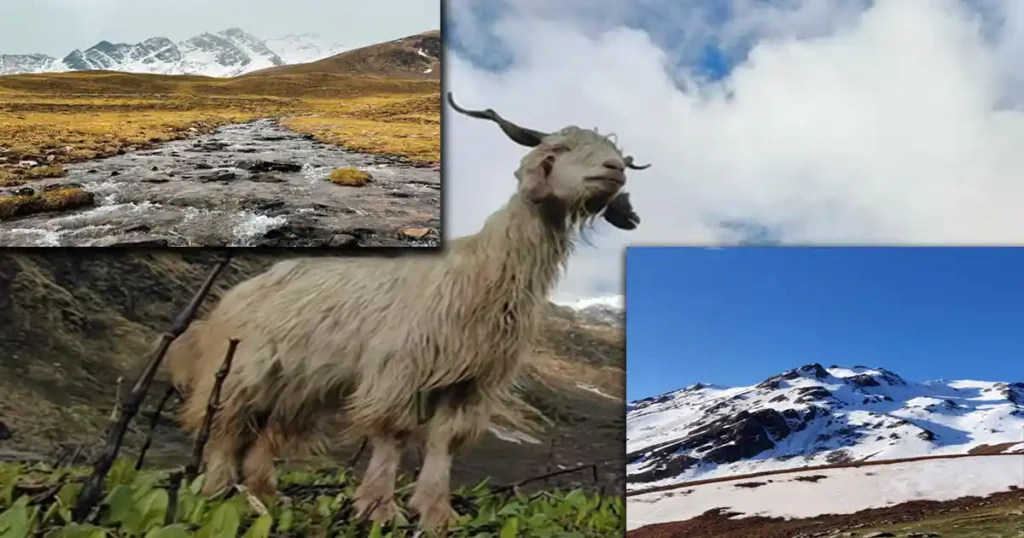
d. Day 04: Nagaru – Sar Pass – Biskeri Thach
• Distance: 14 Kms;
• Trek Grade: Moderate -Difficult
• Altitude: Nagaru (12467 Ft); Sar Pass (13780 Ft), Biskeri Thach (10991 Ft.)
• Time Taken: approx 7-8 Hrs
• Overnight stay at Trekking Tents
Wake before dawn. Yesterday’s trek prepared you for today’s climb to Sar Pass, following a steep ridge southward through high-altitude snow. Walk steadily, navigating challenging terrain with recent snowfall. Reaching the summit, rejoice at Sar Pass, named after the frozen ‘Sar’ pond, offering panoramic views without a typical mountain saddle to cross.
To the east, the lofty peaks of Tosh Valley come into view, alongside a vast expanse of snow-covered mountains to the south, seeming almost reachable. However, summiting would take hours, with more ground to cover before reaching the next camp.
The route continues southeast, navigating carefully around deep valleys to the left. After some time, it ascends to a ridge adorned with a flag tied to a ‘Trishul’ at the peak. The final stretch is steep, possibly with a rope buried in the snow for assistance, marking a true mountain pass.
Reaching the summit reveals an exhilarating view. A sharp drop of several hundred feet unveils a stunning valley ahead. This moment, amidst snowfall and poor visibility, was the highlight of my trek, a surreal experience that filled me with excitement.
Slide down the slope safely by securing loose items and keeping your legs together to control speed. The slide can cover up to a kilometer, leading to a gentler valley slope. Further along, another optional slide down a less steep slope is possible, followed by a steeper descent suitable for sliding if conditions allow.
The route winds through a narrowing valley past snow-covered trees, revealing the scenic Biskeri Thach campsite after crossing streams. Biskeri offers panoramic views of pine forests, majestic mountains, and lush grasslands. Below lie villages like Tosh, Pulga-Tulga, Bursheni, and Nakthan, with Bun-Buni grassland on a nearby ridge. A waterfall cascades from the mountains behind Biskeri, with water available from a stream and tap. Network coverage is also available.
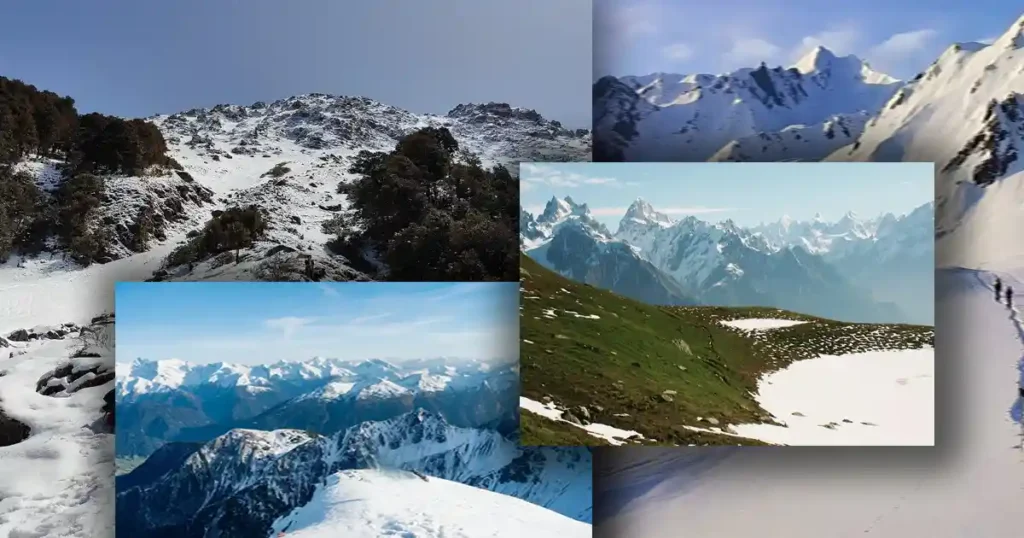
e. Day 5: Biskeri Thach – Barshaini and return to Kasol
• Trek Distance: 10 Kms;
• Trek Grade: Easy
• Altitude: Biskeri Thach (10991 Ft.); Barshaini (7874 ft)
• Time Taken: approx 4-5 Hrs
From Biskeri, descend left of the stream. Cross it and navigate through a fenced plot to find the trail into the dense forest. A guide is essential to choose the correct northeast path. Descend further to find a stream crossing with a campsite and vendor tents. Head left from the campsite towards Pulga village.
After passing through a picturesque grassland fringed by trees, the path descends steeply through a wooded area. You’ll reach a clearing where trees have been felled, passing a fenced property and a forest department lumber yard.
The track follows a water pipeline to Pulga village. Pulga and Tulga, twin villages, are divided by a stream. From Tulga, cross a bridge over the dammed Parvati River for a hydroelectric project to reach Bursheni village. Bursheni, the last road-connected village in Parvati Valley, serves as a base for treks to Kheerganga, Mantalai Lake, Pin Parvati Pass, and Tosh Valley. Buses and taxis to Kasol, Bhuntar, and beyond are available from Bursheni.
Thus ends a memorable trek, leaving behind cherished memories.

Best Season to visit Kanwar Wildlife Sanctuary
The best seasons to visit the Kanwar Wildlife Sanctuary are April to June and September to November. During these times, tourists mainly see the hot springs, gurudwara, and temples. Trekkers, in particular, visit in May and June to ascend through the sanctuary and descend to Pulga.
Approach and Access of Kanwar Wildlife Sanctuary
The Kanwar Wildlife Sanctuary is accessible via NH 21 (NH – 3) up to Bhunter on the Chandigarh-Manali national highway. From Bhunter, it is a 30 km journey to Kasol, the only roadside village in the sanctuary. A metalled road leads into the Parvati Valley from Bhunter, where the Parvati River merges with the Beas River. The valley, through which the Parvati River flows, has numerous villages, mostly concentrated on the northern side.
The sanctuary can be reached by road from Chandigarh, Shimla, and Pathankot with the following distances:
Chandigarh – Kasol = 270 Km
Shimla – Kasol = 230 Km
Pathankot – Kasol = 332 Km
The nearest towns of Kanwar WLS are Bhunter (30 km) and Kullu (40 km). The nearest airport is Bhunter, which is connected to Shimla, Chandigarh, and Delhi.
The nearest railway station is at Joginder Nagar (145 km from Kasol), linked to the broad-gauge network at Pathankot.
Travel to Kullu is convenient by road or air from Chandigarh or Delhi. A motorable Bhunter-Manikaran road runs through the northern boundary of the sanctuary via Kasol village (5km), and there is a bridle path from Kasol to Grahan.
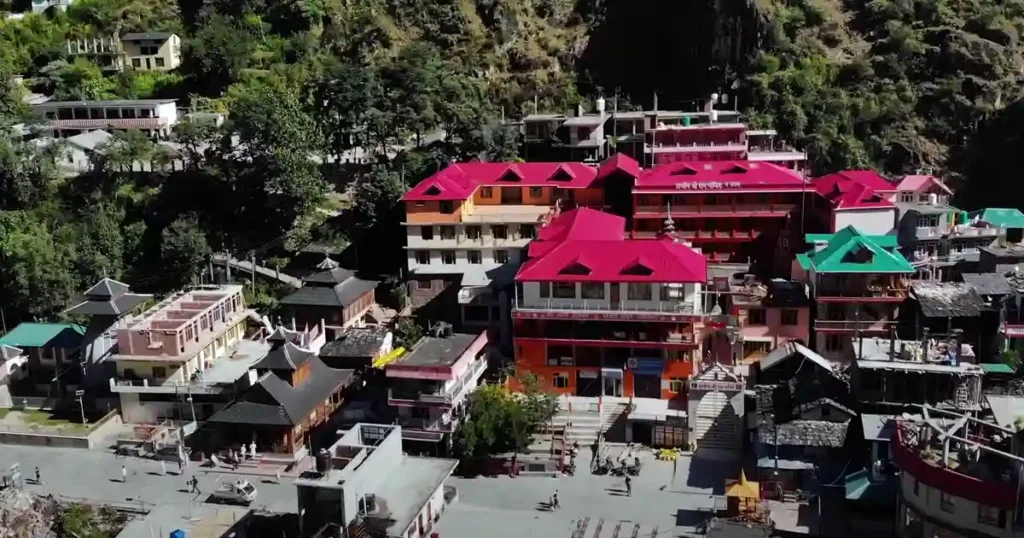
Where to Stay
Over the last twenty years, Kasol and Manikaran have been commercialized into small townships. Back in the early nineties, Kasol was a small village bearing few houses. Today numerous houses, hotels, and restaurants have sprung up in the region. The human concentration has multiplied with an increase in tourist flow, the reason not being reproduction but migration from surrounding villages and outside.
Conclusion
Established in 1954 with an area of 54.27 sq. km. and following the Hon’ble Supreme Court order (IA No. 155, dated 01/02/2013) for the rationalization of boundaries, Kanwar Wildlife Sanctuary declared as WLS on 1st February 2014 covering 107.29 km². This WLS located in the Kullu Valley (popularly known as “Dev Bhumi”), is characterized by forested landscapes, snow-capped mountain peaks, and towering trees that are home to a variety of birds and animals, making it an ideal and potential eco-tourism spot.
Kasol and Manikaran have consistently worked towards improving amenities for visitors to enjoy its natural beauty and cultural heritage. Kanwar Wildlife Sanctuary is a good alternative for tourists who love nature and are interested in trekking adventures.
FAQ
a. What animals are in Kanwar Wildlife Sanctuary?
Kanwar Wildlife Sanctuary is home to a viable population of the Himalayan Tahr and shelters many species listed in the IUCN Red List and CITES appendices, such as the Snow leopard, Himalayan Black Bear, Himalayan Brown Bear, and Common Leopard, among others. Common birds found in the sanctuary include the state bird of Himachal Pradesh, the Western Tragopan, and Monal, as well as various thrushes, tits, and warblers.
b. What is the state animal of Himachal Pradesh?
The snow leopard is the state animal of Himachal Pradesh which is found in Kanwar Wildlife Sanctuary.
c. What animals are in Kullu?
Animals found in the Kullu Valley, which are IUCN Red-listed species, include the Snow leopard, Himalayan black bear, Himalayan brown bear, Himalayan red fox, jackals, serow, civets, Himalayan tahr, Musk deer, blue sheep, Goral, Monal, Koklas, Kalij, and Western Tragopan.
You May Also Like
- Simbalbara National Park
- Pin Valley National Park
- Khirganga National Park
- Inderkilla National Park
- Murlen National Park



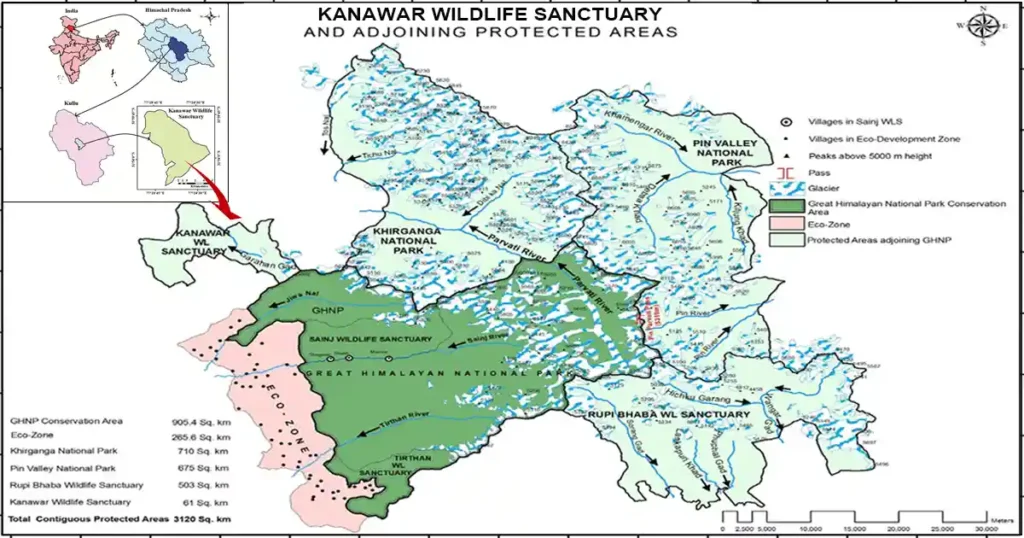

2 thoughts on “Kanwar Wildlife Sanctuary”